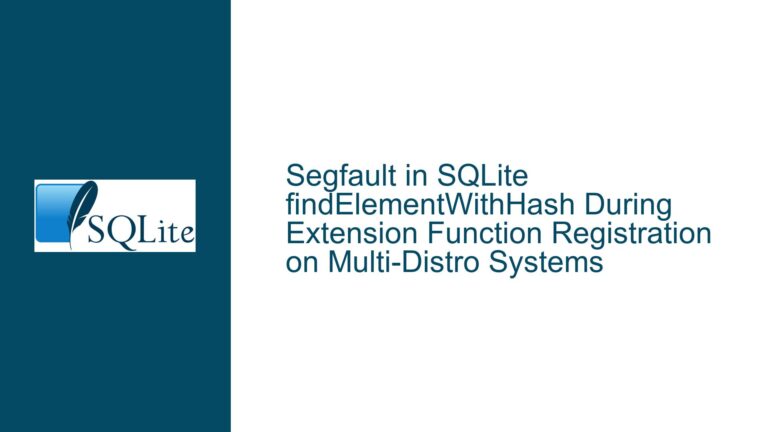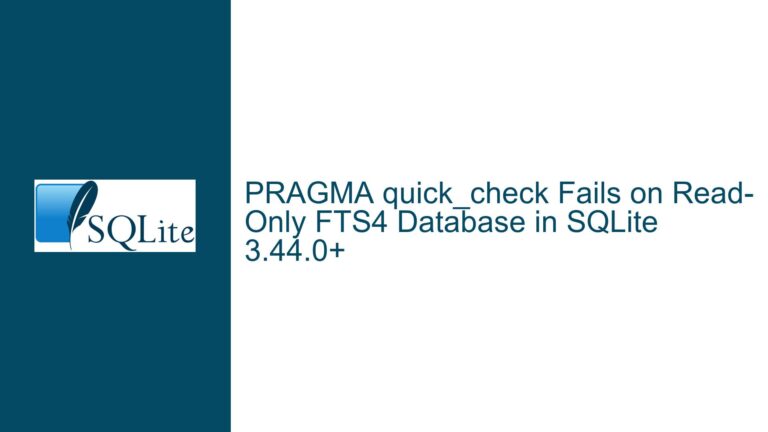and Fixing sqlite3_stmt_readonly Behavior in SQLite
Issue Overview: sqlite3_stmt_readonly Dependency on Database State
The sqlite3_stmt_readonly function in SQLite is designed to determine whether a prepared statement is read-only, meaning it does not modify the database. However, the behavior of this function can be inconsistent and confusing, particularly when the state of the database changes after the statement is prepared. The core issue arises from the fact that sqlite3_stmt_readonly evaluates the read-only status of a statement based on the current state of the database at the time the function is called, rather than at the time the statement was prepared. This can lead to unexpected results, especially when dealing with statements that may or may not modify the database depending on the schema, such as CREATE TABLE IF NOT EXISTS.
For example, consider a scenario where a CREATE TABLE IF NOT EXISTS statement is prepared. If the table already exists, the statement is effectively a no-op and does not modify the database. However, if the table does not exist, the statement will create the table, thus modifying the database. The sqlite3_stmt_readonly function may return different results depending on whether the table exists at the time the function is called, rather than at the time the statement was prepared. This behavior can be particularly problematic in applications that rely on the read-only status of statements to make decisions about database access or transaction management.
Furthermore, the behavior of sqlite3_stmt_readonly is not consistent across all types of statements. For example, an UPDATE statement that does not actually change any data (e.g., because the WHERE clause does not match any rows) will still be classified as read/write by sqlite3_stmt_readonly, even though it does not modify the database. This inconsistency can lead to confusion and potential bugs in applications that rely on the function to determine whether a statement is safe to execute in a read-only context.
Possible Causes: Schema Changes and Statement Re-preparation
The root cause of the inconsistent behavior of sqlite3_stmt_readonly lies in the way SQLite handles schema changes and statement re-preparation. When a schema change occurs (e.g., a table is created or dropped), SQLite may automatically re-prepare statements that were previously prepared. This re-preparation can change the classification of a statement from read-only to read/write or vice versa, depending on the new state of the database.
For example, consider the following sequence of events:
- A
CREATE TABLE IF NOT EXISTSstatement is prepared. At this point, the table does not exist, so the statement is classified as read/write. - The table is created by another statement or process.
- The
CREATE TABLE IF NOT EXISTSstatement is re-prepared due to the schema change. Now that the table exists, the statement is classified as read-only.
This re-preparation process can lead to situations where the read-only status of a statement changes unexpectedly, depending on the current state of the database. This behavior is particularly problematic for applications that need to make decisions based on the read-only status of a statement at the time it was prepared, rather than at the time it is executed.
Another contributing factor to the inconsistent behavior of sqlite3_stmt_readonly is the way SQLite classifies different types of statements. SQLite uses a set of internal rules to determine whether a statement is read-only or read/write. These rules are based on the syntax of the statement and the current state of the database. However, these rules do not always align with the intuitive understanding of what constitutes a read-only statement. For example, an UPDATE statement that does not modify any data is still classified as read/write, even though it does not change the database.
Troubleshooting Steps, Solutions & Fixes: Addressing sqlite3_stmt_readonly Inconsistencies
To address the inconsistencies and confusion surrounding the sqlite3_stmt_readonly function, several approaches can be taken. These include modifying the behavior of the function, introducing new APIs, and improving documentation to clarify the expected behavior.
Modifying sqlite3_stmt_readonly Behavior
One approach to addressing the issue is to modify the behavior of sqlite3_stmt_readonly so that it returns a consistent result regardless of the current state of the database. For example, the function could be changed to always return FALSE for CREATE TABLE statements, even if the statement is a no-op due to the table already existing. This change would align with the intuitive understanding that CREATE TABLE statements are inherently read/write, regardless of whether they actually modify the database.
However, this approach has the potential to break legacy applications that rely on the current behavior of sqlite3_stmt_readonly. To mitigate this risk, a new version of the function, such as sqlite3_stmt_readonly_v2, could be introduced. This new function would implement the modified behavior, while the original sqlite3_stmt_readonly function would remain unchanged for backward compatibility.
Introducing New APIs for Statement Classification
Another approach is to introduce new APIs that provide more granular control over statement classification. For example, a new function could be introduced that returns a MAYBE result for statements whose read-only status depends on the current state of the database. This would allow applications to handle these cases more explicitly, rather than relying on the potentially inconsistent behavior of sqlite3_stmt_readonly.
For example, a new function sqlite3_stmt_readonly_v2 could be introduced with the following behavior:
- Return
TRUEfor statements that are guaranteed to be read-only (e.g.,SELECTstatements). - Return
FALSEfor statements that are guaranteed to be read/write (e.g.,INSERT,UPDATE,DELETE). - Return
MAYBEfor statements whose read-only status depends on the current state of the database (e.g.,CREATE TABLE IF NOT EXISTS).
This approach would provide applications with more control over how they handle statements that may or may not modify the database, depending on the current schema.
Improving Documentation and Clarifying Expected Behavior
In addition to modifying the behavior of sqlite3_stmt_readonly and introducing new APIs, it is important to improve the documentation to clarify the expected behavior of the function. The documentation should clearly explain that the read-only status of a statement may change depending on the current state of the database, particularly for statements that are re-prepared due to schema changes.
The documentation should also provide guidance on how to handle cases where the read-only status of a statement is uncertain. For example, applications that need to ensure that a statement is read-only should check the status of the statement immediately after it is prepared, rather than relying on the status at the time of execution.
Example Code and Best Practices
To help developers understand and work around the limitations of sqlite3_stmt_readonly, the documentation should include example code and best practices for handling statements whose read-only status may change. For example, the following code demonstrates how to check the read-only status of a statement immediately after it is prepared:
sqlite3 *db;
sqlite3_stmt *stmt;
const char *sql = "CREATE TABLE IF NOT EXISTS data(key TEXT);";
// Open the database
sqlite3_open(":memory:", &db);
// Prepare the statement
sqlite3_prepare_v3(db, sql, -1, SQLITE_PREPARE_PERSISTENT, &stmt, NULL);
// Check the read-only status immediately after preparation
int is_readonly = sqlite3_stmt_readonly(stmt);
printf("Readonly: %d\n", is_readonly);
// Execute the statement
sqlite3_step(stmt);
// Finalize the statement
sqlite3_finalize(stmt);
// Close the database
sqlite3_close(db);
In this example, the read-only status of the CREATE TABLE IF NOT EXISTS statement is checked immediately after it is prepared. This ensures that the status is evaluated based on the state of the database at the time of preparation, rather than at the time of execution.
Conclusion
The behavior of sqlite3_stmt_readonly in SQLite can be inconsistent and confusing, particularly when dealing with statements whose read-only status depends on the current state of the database. To address these issues, developers can modify the behavior of the function, introduce new APIs for statement classification, and improve documentation to clarify expected behavior. By following best practices and understanding the limitations of sqlite3_stmt_readonly, developers can avoid potential bugs and ensure that their applications handle database statements correctly.






